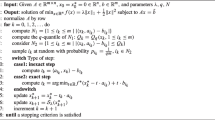Abstract
Under α stable distribution impulse noise environment, the least mean p-power algorithm (LMP) cannot handle the instability of the algorithm well, due to the large amplitude of the input signal and the large number of useless small weight coefficients in the sparse channel, which delay the convergence speed of the algorithm. In this paper, we develop a new adaptive filtering algorithm, named the proportional normalization least mean p-power (PNLMP) adaptive filtering algorithm. We first introduce a step size control matrix to improve the overall convergence speed and convergence accuracy of the algorithm. Next, to reduce the influence of a large impulse response on the LMP algorithm, a high-order tongue-line function about error is introduced in the normalization processing. Finally, we extend the tongue-line function to ensure that the cost function can also switch freely between V-shaped and M-shaped. This new algorithm overcomes the problem that the traditional LMP algorithm is only applicable to a specific environment and solves the problem of slow convergence speed and low convergence accuracy. Under α stable distribution impulse noise environment, the simulations show that the PNLMP algorithm can improve the convergence speed and stronger system tracking capability compared with existing algorithms, overcoming the problems of slow overall convergence and low convergence accuracy in the traditional algorithm.








Similar content being viewed by others
Data Availability
Data sharing not applicable to this article as no datasets were generated or analyzed during the current study.
References
O. Arikan, A.E. Cetin, E. Erzin, Adaptive filtering for non-Gaussian stable processes. IEEE Signal Process. Lett. 1(11), 163–165 (1994). https://doi.org/10.1109/97.335063
B. Chen, L. Xing, H. Zhao, N. Zheng, J.C. Principe, Generalized correntropy for robust adaptive filtering. IEEE Trans. Signal Process. 64(13), 3376–3387 (2016). https://doi.org/10.1109/TSP.2016.2539127
B. Chen, L. Xing, J. Liang, N. Zheng, J.C. Principe, Steady-state mean-square error analysis for adaptive filtering under the maximum correntropy criterion. IEEE Signal Process. Lett. 21(7), 880–884 (2014). https://doi.org/10.1109/LSP.2014.2319308
Y.-R. Chien, Variable regularization affine projection sign algorithm in impulsive noisy environment. IEICE Trans. Fundam. E102.A(5), 725–728 (2019). https://doi.org/10.1587/transfun.E102.A.725
Y.-R. Chien, L.-Y. Jin, Convex combined adaptive filtering algorithm for acoustic echo cancellation in hostile environments. IEEE Access 6, 16138–16148 (2018). https://doi.org/10.1109/ACCESS.2018.2804298
Y.-R. Chien, C.-H. Yu, H.-W. Tsao, Affine-projection-like maximum correntropy criteria algorithm for robust active noise control. IEEE/ACM Trans. Audio Speech Lang. Process. 30, 2255–2266 (2022). https://doi.org/10.1109/TASLP.2022.3190720
M.A. Chitre, J.R. Potter, S.-H. Ong, Optimal and near-optimal signal detection in snapping shrimp dominated ambient noise. IEEE J. Oceanic Eng. 31(2), 497–503 (2006). https://doi.org/10.1109/JOE.2006.875272
L.D. Davisson, G. Longo, Adaptive Signal Processing (Springer Vienna, Vienna, 1991)
D.L. Duttweiler, Proportionate normalized least-mean-squares adaptation in echo cancelers. IEEE Trans. Speech Audio Process. 8(5), 508–518 (2000). https://doi.org/10.1109/89.861368
A.-H. Enrique, B. David, D.P. Ruiz, M.C. Carrion, The averaged, overdetermined, and generalized LMS algorithm. IEEE Trans. Signal Process. 55(12), 5593–5603 (2007). https://doi.org/10.1109/TSP.2007.899375
E. Eweda, A stable normalized least mean fourth algorithm with improved transient and tracking behaviors. IEEE Trans. Signal Process. 64(18), 4805–4816 (2016). https://doi.org/10.1109/TSP.2016.2573747
E. Eweda, Stabilization of high-order stochastic gradient adaptive filtering algorithms. IEEE Trans. Signal Process. 65(15), 3948–3959 (2017). https://doi.org/10.1109/TSP.2017.2698364
F. Huang, J. Zhang, S. Zhang, Maximum versoria criterion-based robust adaptive filtering algorithm. IEEE Trans. Circuits Syst. II Express Briefs 64(10), 1252–1256 (2017). https://doi.org/10.1109/TCSII.2017.2671521
Z. Jin, L. Guo, Y. Li, The bias-compensated proportionate NLMS algorithm with sparse penalty constraint. IEEE Access 8, 4954–4962 (2020). https://doi.org/10.1109/ACCESS.2019.2962861
R.H. Kwong, E.W. Johnston, A variable step size LMS algorithm. IEEE Trans. Signal Process. 40(7), 1633–1642 (1992). https://doi.org/10.1109/78.143435
M. Li, L. Li, H.-M. Tai, Variable step size LMS algorithm based on function control. Circuits Syst. Signal Process. 32(6), 3121–3130 (2013). https://doi.org/10.1007/s00034-013-9598-z
J. Liu, S.L. Grant, A generalized proportionate adaptive algorithm based on convex optimization, in 2014 IEEE China Summit & International Conference on Signal and Information Processing (ChinaSIP). pp. 748–752 (2014). https://doi.org/10.1109/ChinaSIP.2014.6889344.
S.-C. Pei, C.-C. Tseng, Least mean p-power error criterion for adaptive FIR filter. IEEE J. Sel. Areas Commun. 12(9), 1540–1547 (1994). https://doi.org/10.1109/49.339922
S.-C. Pei, C.-C. Tseng, Adaptive IIR notch filter based on least mean p-power error criterion. IEEE Trans. Circuits Syst. II: Analog Digital Signal Process. 40(8), 525–528 (1993). https://doi.org/10.1109/82.242343
M.O. Sayin, N.D. Vanli, S.S. Kozat, A novel family of adaptive filtering algorithms based on the logarithmic cost. IEEE Trans. Signal Process. 62(17), 4411–4424 (2014). https://doi.org/10.1109/TSP.2014.2333559
H.-C. Shin, A.H. Sayed, Mean-square performance of a family of affine projection algorithms. IEEE Trans. Signal Process. 52(1), 90–102 (2004). https://doi.org/10.1109/TSP.2003.820077
B. Wang, T. Fang, Y. Dai, Method of Time reversal filter bank multicarrier underwater acoustic communication. 45(1), 38–44 (2020).
K. Xiong, Y. Zhang, S. Wang, Robust variable normalization least mean p-power algorithm. Sci. China Inf. Sci. 63(9), 199204 (2020). https://doi.org/10.1007/s11432-018-9888-0
S. Zhang, W. Zheng, J. Zhang, H. Han, A family of robust M-shaped error weighted least mean square algorithms: Performance analysis and echo cancellation application. IEEE Access 5, 14716–14727 (2017). https://doi.org/10.1109/ACCESS.2017.2722464
Acknowledgements
This work was supported in part by the National Natural Science Foundation of China under Grant 52071164 and in part by the Postgraduate Research & Practice Innovation Program of Jiangsu Province under Grant KYCX22_3844.
Author information
Authors and Affiliations
Corresponding author
Ethics declarations
Conflict of interest
The authors have no conflicts of interest to declare.
Additional information
Publisher's Note
Springer Nature remains neutral with regard to jurisdictional claims in published maps and institutional affiliations.
Rights and permissions
Springer Nature or its licensor (e.g. a society or other partner) holds exclusive rights to this article under a publishing agreement with the author(s) or other rightsholder(s); author self-archiving of the accepted manuscript version of this article is solely governed by the terms of such publishing agreement and applicable law.
About this article
Cite this article
Cai, B., Wang, B., Zhu, B. et al. An Improved Proportional Normalization Least Mean p-Power Algorithm for Adaptive Filtering. Circuits Syst Signal Process 42, 6951–6965 (2023). https://doi.org/10.1007/s00034-023-02441-z
Received:
Revised:
Accepted:
Published:
Issue Date:
DOI: https://doi.org/10.1007/s00034-023-02441-z




